Older Aboriginal and Torres Strait Islander people
Aboriginal and Torres Strait Islander people are the Indigenous peoples of Australia. They are not one group, but rather comprise hundreds of groups that have their own distinct set of languages, histories and cultural traditions.
Aboriginal and Torres Strait Islander people continue to suffer from the consequences of European settlement, including the impact of ‘new’ infectious and chronic diseases. The interaction of other factors, including social dislocation and economic disadvantage, also contribute to poor health in many groups of Aboriginal and Torres Strait Islander people (AIHW 2015). Aboriginal and Torres Strait Islander people are more likely to develop serious medical conditions earlier in life and have a lower life expectancy than non-Indigenous Australians (AIHW 2017). In recognition of this, this feature article focuses on Aboriginal and Torres Strait Islander people aged 50 and over.
Demographic profile
In 2016, an estimated 124,000 Australians aged 50 and over identified as being of Aboriginal and/or Torres Strait Islander origin. Older Indigenous Australians (aged 50 and over) comprise 1.5% of the total Australian population aged 50 and over and 16% of the total Indigenous population. The Indigenous population is ageing, with the proportion aged 50 and over increasing over recent years. This growth is projected to continue and by 2031 it is expected that 1 in 5 Indigenous people will be aged 50 or over (20%) (ABS 2019a). Due to higher rates of fertility and deaths occurring at younger ages, the Indigenous population has a much younger age structure than the non-Indigenous population (AIHW 2019).
One in 4 older Indigenous Australians (aged 50 and over) were aged 65 and over (27%) in 2016. This proportion was slightly higher for women (28%) than men (26%), reflecting the higher life expectancy of women (ABS 2019a) (Figure 2A.1).
Figure 2A.1: Estimated resident Indigenous Australian population by age group and sex, 2016
The butterfly chart shows that the population of Indigenous Australians is predominately young people. Approximately 15% of Indigenous men and 16% of Indigenous women were aged 50 and over in 2016. This is in comparison to 55% of Indigenous men and 52% of Indigenous women aged under 25.
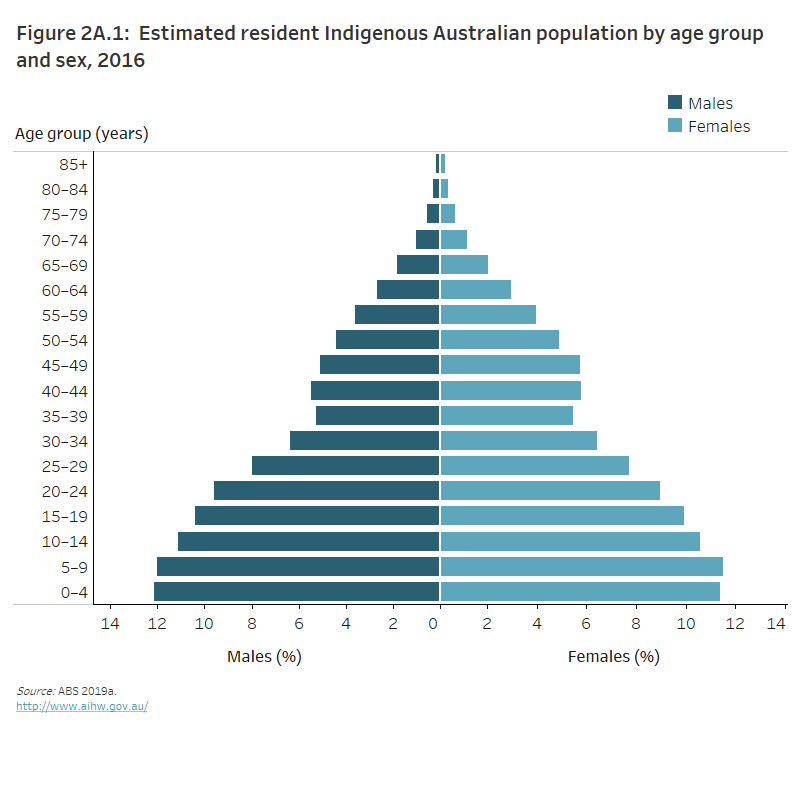
While the number of older Indigenous Australians has increased over recent years, and is projected to continue increasing, the split of men and women in the 50 and over age group has remained stable. Just over half (53%) of this population were women in 2001, 2006, 2011 and 2016 (ABS 2019a) (Figure 2A.2). For the 85 and over age group, women made up around two-thirds of the population in 2006, 2011 and 2016 (66%, 67% and 66%, respectively). This is an increase from 6 in 10 (60%) in 2001 (ABS 2019a).
Figure 2A.2: Estimated resident and projected older Indigenous population (50 and over) by sex, 2001 to 2031
The stacked column graph shows that the number of older Indigenous Australians (aged 50 and over) has grown and is projected to continue growing to 2031. The number of older Indigenous females is projected to be larger than the number of older Indigenous males. The line graph shows that the proportion of Indigenous people aged 50 and over is rising and is projected to continue to rise.

Among the 124,000 older Indigenous Australians (aged 50 and over) in 2016:
- 91% (113,300) identified as being of Aboriginal origin only
- 6% (7,100) identified as being of Torres Strait Islander origin only
- 3% (3,600) identified as being of both Aboriginal and Torres Strait Islander origin (ABS 2018).
This is broadly consistent with the total Indigenous population in 2016, of which:
- 91% (727,500) identified as being of Aboriginal origin only
- 5% (38,700) identified as being of Torres Strait Islander origin only
- 4% (32,200) identified as being of both Aboriginal and Torres Strait Islander origin (ABS 2017).
In 2016:
- Around 1 in 3 older Indigenous Australians (aged 50 and over) lived in New South Wales (35%) and 1 in 4 lived in Queensland (26%).
- The highest proportion of older Indigenous Australians lived in Major cities (35%) and 1 in 5 (20%) lived in Remote or Very remote areas.
- Around half (51%) of older Indigenous Australians lived in 8 of the 37 Indigenous Regions (IREG) (ABS 2018; AIHW 2019).
Health
The 2018–19 National Aboriginal and Torres Strait Islander Health Survey (NATSIHS) was conducted between July 2018 and April 2019 (ABS 2019c) and the following data are based on self-reporting by older Indigenous Australians (aged 50 and over) unless noted otherwise. While almost 1 in 5 older Indigenous survey respondents self-assessed their health as poor (19%, 26,100), more than half (58%, 78,800) self-assessed their health as good, very good or excellent.
Health risk factors
A healthy diet can help to prevent and manage many chronic conditions, including type 2 diabetes, cardiovascular disease and some forms of cancer. The National Health and Medical Research Council (NHMRC 2013) recommends that adults have 2 servings of fruit and 5 servings of vegetables every day for a healthy lifestyle. In 2018–19:
- Around 1 in 25 (3.7%, 5,000) older Indigenous survey respondents met both the fruit and vegetable daily intake guidelines.
- More than a third (39%, 52,600) met the fruit guidelines only.
- 1 in 50 (2.2%, 3,000) met the vegetable guidelines only.
- More than half (56%, 75,900) did not meet either the fruit or vegetable intake guidelines (ABS 2019c).
More than half of older Indigenous Australians had a measured body mass index (BMI) range of obese (51%, 69,100) and a further 3 in 10 (31%, 41,500) had a measured BMI in the overweight range.
The consumption of alcohol, tobacco and other drugs is a major cause of preventable disease, illness and death in Australia. Based on responses about alcohol consumption in the last 12 months:
- Nearly 4 in 10 (39%, 52,800) Indigenous Australians aged 50 and over reported exceeding single occasion alcohol risk guidelines of more than 5 standard drinks.
- Around half (52%, 27,200) of those who had exceeded single occasion risk guidelines had exceeded 11 standard drinks on one occasion.
- Nearly 1 in 4 (23%, 30,600) had not consumed alcohol.
Tobacco is one of the leading risk factors contributing to the burden of disease for older Australians. Among older Indigenous Australians in 2018–19, around 1 in 3 (36%, 48,100) smoked daily and almost 1 in 10 (9.5%, 12,900) lived in a household where a daily smoker smoked at home indoors. Around 1 in 3 (35%, 48,000) were ex-smokers, and just over 1 in 4 (26%, 35,000) had never smoked.
Health status
As noted earlier, Aboriginal and Torres Strait Islander Australians tend to develop chronic conditions earlier in life than non-Indigenous Australians. In 2018–19, more than 1 in 3 (35%, 47,400) older Indigenous Australians (aged 50 and over) self-reported they had been advised, by a doctor or nurse, of having diabetes or high sugar levels.
Of the 27% (37,000) of older Indigenous Australians who reported having asthma, only around 1 in 4 (28%, 10,200) had a written asthma action plan. More than 1 in 10 (12%, 4,300) had either never heard of or didn’t know if they had a written asthma action plan.
Cultural safety is the practice of treating a person from another culture without any action that diminishes, demeans or disempowers them or their cultural identity. Improving cultural safety for Aboriginal and Torres Strait Islander health care users can improve access to, and the quality of, health care. This means a health system that respects Indigenous cultural values, strengths and differences, and also addresses racism and inequity (AIHW 2021a).
The Royal Commission into Aged Care Quality and Safety states that ‘cultural safety must be embedded throughout aged care’. It proposes an Aboriginal and Torres Strait Islander aged care pathway that brings culturally safe and flexible aged care that meets the needs of Indigenous people wherever they live (RCACQS 2021).
For more information see Cultural safety in health care for Indigenous Australians: monitoring framework and RCACQS final report: care, dignity and respect.
Aged care
Access to aged care services in Australia is determined by need, rather than age. The Aged Care Act 1997 designates some groups of people as ‘people with special needs’ (AIHW 2019). Indigenous Australians are one such group. Other groups designated as ‘people with special needs’ in the Aged Care Act include people from culturally and linguistically diverse (CALD) backgrounds, veterans, people who live in rural or remote areas, and lesbian, gay, bisexual, transgender and intersex (LGBTI) people.
Planning for aged care services takes into account the specific needs of the Indigenous population aged 50 and over and the non-Indigenous population aged 65 and over (Department of Health 2017). A broader age group is used for Indigenous Australians because of their greater need for care at a younger age compared with non-Indigenous Australians (AIHW 2019).
The aged care journey begins with an assessment process. In 2019–20, 3,745 aged care assessments for older Indigenous Australians were conducted, an increase from 3,392 in 2018–19. This continues an overall trend, in recent years, of increasing numbers of Indigenous Australians using aged care services (Figure 2A.3).
Figure 2A.3: Number of aged care assessments for older Australians (50 and over) by Indigenous status, 2016–17 to 2019–20
The line graphs show that the number of assessments for aged care services for older Indigenous Australians has increased in the last four years (from 2,700 in 2016–17 to 3,700 in 2019–20). The number of assessments for aged care services for older Indigenous and non-Indigenous Australians decreased in 2018–19, however increased to a 4-year peak in 2019–20.
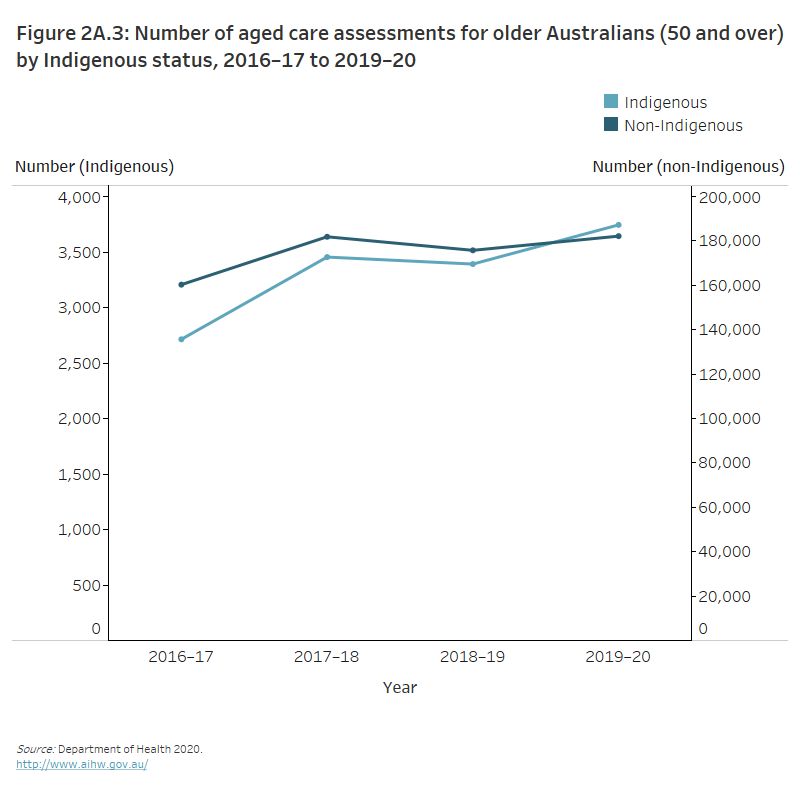
Around 5,300 older Indigenous Australians were using aged care services (home, residential or transition care) at 30 June 2020. This represented 1.6% of all Australians aged 50 and over who were using aged care services. Around half of these older Indigenous Australians (48%, 2,600 people) were aged between 65 and 79 years. In addition, 50 Indigenous Australians aged under 50 were using aged care services (Figure 2A.4).
There is a considerable difference in the age profile of Indigenous Australians using aged care services, compared with non-Indigenous Australians (Figure 2A.4). While part of the reason is the broader age range at which Indigenous Australians can access aged care services, it also reflects the lower life expectancy of Indigenous Australians and the younger age at which services are needed (AIHW 2020b).
Figure 2A.4: People using aged care services by Indigenous status and age, 30 June 2020
The butterfly chart shows that the profile of Indigenous Australians differs across aged care services. Indigenous Australians in permanent residential care, home care and home support are often younger than non-Indigenous Australians (22% of Indigenous Australians in permanent residential care were aged under 65, compared with 2.4% of non-Indigenous Australians).
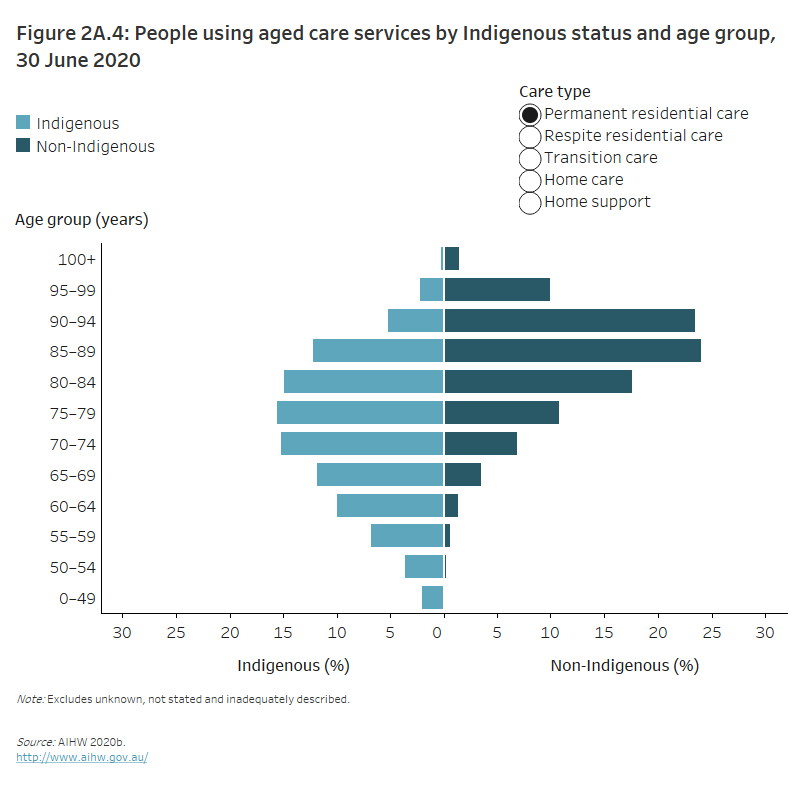
Almost 2 in 3 (65%) older Indigenous Australians using aged care services were women and around 1 in 3 (35%) were men. Women made up 57% of the 50–54 age group and nearly three-quarters (73%) of the 85 and over age group.
Service type
The three biggest aged care programs are residential aged care, home support and home care (see ‘Types of aged care’ in the Aged care article). At 30 June 2020, 5,400 Indigenous Australians were using residential aged care (permanent or respite), home care or transition care in Australia. In addition, during 2019–20, nearly 22,300 Indigenous Australians were assisted under the Commonwealth Home Support Programme.
At 30 June 2020, Indigenous Australians accounted for:
- 1.0% (2,000) of people living in residential aged care
- 2.4% (3,400) of people using home care
- 0.6% (20) of people using transition care
- 2.7% (22,300) of people using home support (during 2019–20) (AIHW 2021b).
The split between the use of home and residential care types contrasts markedly between Indigenous and non-Indigenous Australians. Around 1 in 3 (36%) older Indigenous Australians (aged 50 and over) using aged care services at 30 June 2020 were living in residential care, and 2 in 3 (64%) were using home care. In comparison, around 1 in 3 (32%) non-Indigenous Australians (aged 65 and over) using aged care services at 30 June 2020 were using home care, and around 2 in 3 (67%) were living in residential care. While residential care becomes more common with older age, differences in service type use remained between Indigenous and non-Indigenous Australians (Table 2A.1).
Table 2A.1: Aged care service type by Indigenous status and age group, at 30 June 2020
|
Age group (years) |
Permanent residential care (%) |
Respite residential care (%) |
Home care (%) |
Transition care (%) |
||||
|
|
Indigenous |
Non-Indigenous |
Indigenous |
Non- Indigenous |
Indigenous |
Non- Indigenous |
Indigenous |
Non- Indigenous |
|
50–64 |
27 |
83 |
1.8 |
1.8 |
71 |
15 |
0.4 |
0.6 |
|
65–79 |
30 |
56 |
1.5 |
2.1 |
68 |
40 |
0.3 |
1.2 |
|
80 and over |
48 |
68 |
3.4 |
2.1 |
48 |
29 |
0.4 |
0.8 |
Source: AIHW 2021b.
In each year since June 2016, the proportion of older Indigenous Australians using home care has been increasing, while use of residential care has been generally decreasing (Figure 2A.5).
Figure 2A.5: Older Australians (50 and over) using aged care services by Indigenous status and care type, 30 June 2010–2020
The stacked column graph shows that the greatest proportion of older Indigenous people using aged care services since 2010 were using home care. This is in comparison to non-Indigenous Australians who most commonly used residential care. The proportion of older Indigenous Australians using home care has increased since 2016 (from 56% to 64%).
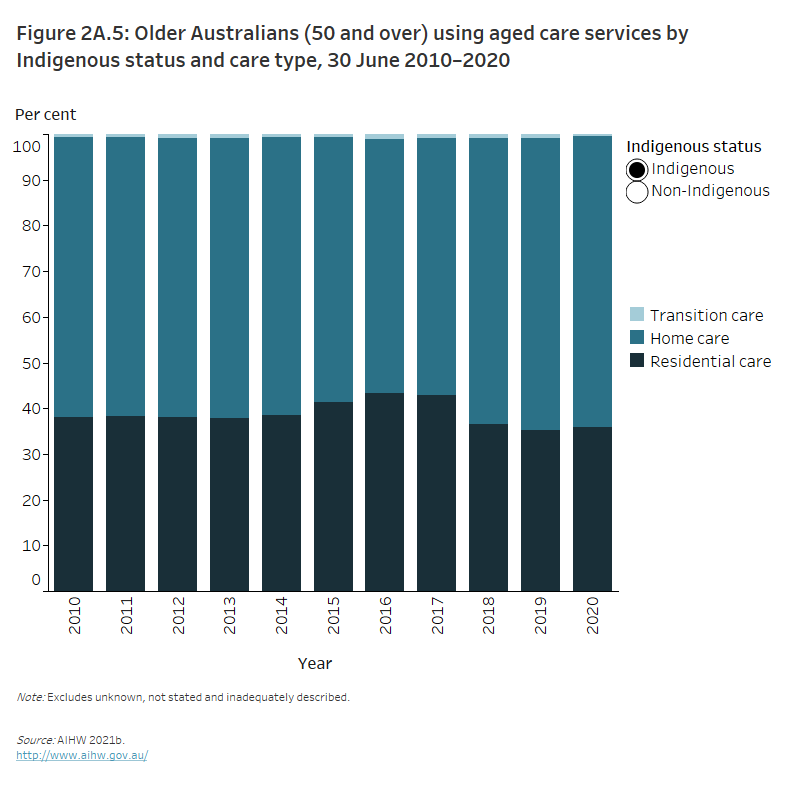
Home care
At 30 June 2020, 3,400 older Indigenous Australians were using home care. Note that Indigenous identification for people using home care is relatively poor, with more than 1 in 3 people using home care having an Indigenous status of ‘not stated’ (36%, 51,900).
While home care is the most common service type for both Indigenous men and women aged 50 and over using aged care services, women are more likely to use home care services – 67% compared with 58% of men. At 30 June 2020, 44% of older Indigenous Australians using home care were receiving level 2 care (low care needs) and nearly 1 in 3 (31%) were receiving level 4 care (high care needs). Level 1 care (basic care needs) was the least common level of home care being received (1.1%) (Figure 2A.6).
The percentages of non-Indigenous older Australians receiving each level of home care are similar to those for Indigenous older Australians. Of the non-Indigenous Australians aged 65 and over using home care, around 4 in 10 (41%) were receiving level 2 care and 1 in 3 (33%) were receiving level 4 care. Level 1 care was the least common level of care being received (1.7%).
Figure 2A.6: Older Australians’ (50 and over) home care level by age and Indigenous status, 2019–20
The pie chart shows the distribution of older Australians across home care levels in 2019–20. Both older Indigenous and non-Indigenous Australians predominantly used home care levels 2 and 4, 75% and 74% respectively.
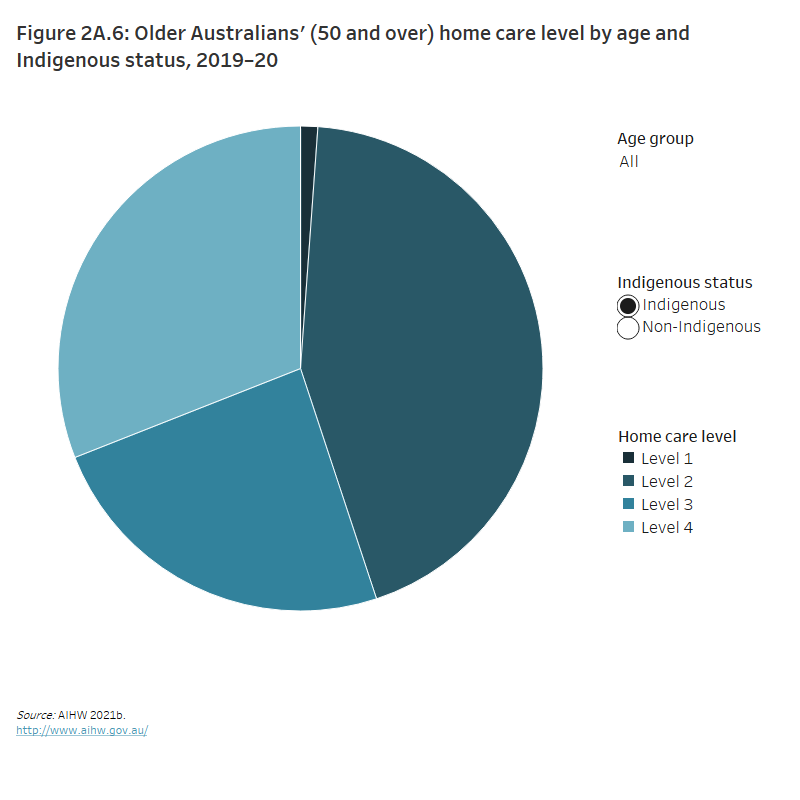
Residential aged care
At 30 June 2020, 1,900 older Indigenous Australians were living in residential aged care. Most of these people were using permanent residential aged care services (1,800), with 100 using respite residential aged care services. At 30 June 2019, the most common medical conditions of all Indigenous Australians living in permanent residential aged care were:
- depression or other mood disorders, such as bipolar (40% of residents)
- dementia (34%)
- arthritis (30%)
- type 2 diabetes (25%).
In comparison, the most common medical conditions of all non-Indigenous Australians living in permanent residential aged care at 30 June 2019 were:
- depression or other mood disorders (49%)
- arthritis (44%)
- dementia (40%)
- anxiety disorders (27%) (AIHW 2020a).
The Aged Care Funding Instrument (ACFI) is used to assess residents’ ongoing care needs to determine the amount of subsidy to be paid by the Australian Government. The ACFI is made up of 12 questions about a resident’s assessed care needs and 2 diagnostic sections. It is not a comprehensive medical assessment. The medical conditions data reported above are from ACFI assessments and should be interpreted in context of this limitation.
Of the 1,700 times an older Indigenous Australian exited permanent residential aged care in 2019–20, 3 in 10 (30%) exits were due to death. The most common reason for discharge was an exit to home or community (37%).
On average, older Indigenous Australians stayed in residential aged care for nearly 12 months (376 days) and older non-Indigenous Australians for around 14 months (440 days). The average length of stay in residential aged care differed by reason of discharge (Table 2A.2).
Table 2A.2: Average length of stay in residential aged care (days) by Indigenous status, sex and discharge reason, 2019–20
|
Discharge reason |
Indigenous (50 years and over) |
Non-Indigenous (65 years and over) |
||||
|
|
Men |
Women |
Total |
Men |
Women |
Total |
|
Home or community |
45 |
59 |
52 |
35 |
38 |
37 |
|
Another residential service |
535 |
323 |
416 |
367 |
470 |
428 |
|
Hospital |
107 |
154 |
133 |
88 |
118 |
104 |
|
Death |
863 |
1,117 |
1,007 |
740 |
1,108 |
959 |
Source: AIHW 2021b.
National Aboriginal and Torres Strait Islander Flexible Aged Care Program
Older Indigenous Australians (aged 50 and over) can also access aged care services through the National Aboriginal and Torres Strait Islander Flexible Aged Care Program (NATSIFACP). The NATSIFACP provides culturally safe aged care to Aboriginal and Torres Strait Islander people to remain close to home and community and is located mainly in remote areas. Services can be delivered in a residential or home setting. See ‘Cultural safety’ box above.
In 2019–20, 1,264 aged care places were provided through 42 aged care services under the NATSIFACP. Most of these places were for home care (770), followed by high care residential care (364) and low care residential care (130). Around half of these places were in the Northern Territory (614). There were no places in the Australian Capital Territory, and the next fewest were in New South Wales (27) (Department of Health 2020).
Social support
In 2018–19 NATSIHS of the older Indigenous Australians (aged 50 and over) living in non-remote locations, almost 7 in 10 agreed (mildly, strongly or very strongly):
- They could count on their friends when things go wrong (69%).
- They could talk about their problems with their family (68%).
- They could talk about their problems with their friends (67%).
- They get the emotional support and help they need from their family (69%).
- Their family really tries to help them (68%) (AIHW analysis of ABS 2019b).
Similarly, in the 2014–15 National Aboriginal and Torres Strait Islander Social Survey (NATSISS) (the most recent data available), around 8 in 10 (81%) older Indigenous Australians (aged 50 and over) reported they could confide in family or friends outside the household. More than half (57%) had daily contact with friends or family outside the household, and a further third (37%) had contact at least once a week (AIHW analysis of ABS 2016).
Justice and safety
As reported in the 2014–15 NATSISS:
- Around 1 in 10 (11%, 10,900) older Indigenous Australians (aged 50 and over) had been imprisoned at least once in their lifetime.
- Around 1 in 15 (6.5%, 6,400) had experienced physical violence in the previous 12 months.
- Almost 1 in 10 (9.5%, 9,400) had experienced threatened physical violence in the previous 12 months (AIHW analysis of ABS 2016).
In the 2014–15 NATSISS, more than 1 in 4 (28%) older Indigenous Australians reported they had received unfair treatment in the previous 12 months because they were of Aboriginal and/or Torres Strait Islander origin. In the previous 12 months, around 1 in 8 (13%) older Indigenous Australians reported avoiding situations due to unfair past treatment that was because they were of Aboriginal and/or Torres Strait Islander origin (AIHW analysis of ABS 2016).
More than 2 in 3 (68%) older Indigenous Australians who walked alone after dark felt safe or very safe walking alone in the local area at night – more than 1 in 5 (23%) felt unsafe or very unsafe. Seven in 10 (70%) older Indigenous Australians were aware of at least one local neighbourhood or community problem. The most commonly reported problems were:
- dangerous and noisy driving (44%)
- theft (43%)
- illegal drugs (37%)
- alcohol (36%) (AIHW analysis of ABS 2016).
Housing and living arrangements
As reported in the 2018–19 NATSIHS, older Indigenous Australians (aged 50 and over) most commonly lived in one-family households (58%), followed by lone-person households (31%). Just over 1 in 5 (21%) older Indigenous Australians in 2018–19 lived in a home that was owned without a mortgage, and a further 1 in 5 (20%) lived in a home that was owned with a mortgage.
The most common landlord types for older Indigenous Australians were:
- state or territory housing authority (39% of renters)
- Indigenous housing organisation or community housing (22%)
- real estate agents (20%).
Around 1 in 12 (8.3%) older Indigenous Australians lived in a household where cooking facilities were either not available or did not work. Just over three-quarters (78%) of older Indigenous Australians lived in a household of an acceptable standard; this is similar to Indigenous Australians aged under 50 (78%) (AIHW analysis of ABS 2019b). An ‘acceptable standard’ means a dwelling with working health hardware (facilities for washing people, clothes and bedding, for safely storing and preparing food, and for removing waste) and no more than 2 major structural problems.
Homelessness
In the 2014–15 NATSISS, nearly 1 in 4 (23%) older Indigenous Australians (aged 50 and over) reported they had experienced homelessness during their lifetime. This proportion was higher in non-remote areas (25%) than remote areas (18%) (AIHW 2019).
On Census night in 2016, nearly 3% of Aboriginal and Torres Strait Islander people aged 50 and over were homeless. More than half (57%) of this group lived in severely crowded dwellings (requiring 4 or more additional bedrooms) and around 1 in 6 (17%) lived in improvised dwellings or tents, or were sleeping out (AIHW 2019).
Less than 1% of non-Indigenous older Australians (aged 65 and over) were homeless on Census night in 2016 (0.4%). Of this group, more than 1 in 4 (28%) were housed in caravan parks, and around 1 in 6 (16%) were staying temporarily with other households (AIHW 2019).
Education and skills
As reported in the 2018–19 NATSIHS, more than half (56%) of older Indigenous Australians (aged 50 and over) had completed at least year 10 or equivalent. Around 1 in 4 (27%) of this group had completed year 12 or equivalent.
Almost half (48%) of older Indigenous Australians had completed a qualification other than pre-primary, primary or secondary education – also known as a non-school qualification. The most commonly reported non-school qualifications of this group were:
- certificates III or IV (43%)
- advanced diploma/diploma (22%)
- certificates I or II (13%)
- bachelor degree (12%) (AIHW analysis of ABS 2019b).
Employment and work
In 2018–19, 1 in 3 (33%) older Indigenous Australians (aged 50 and over) were employed full-time or part-time. This increased to 45% when focusing on those aged 50–64. Half of those aged 50–64 (50%) were not in the labour force (AIHW analysis of ABS 2019b).
Income and finances
In 2018–19, most older Indigenous Australians (aged 50 and over) received a government pension, benefit or allowance as their main source of personal income (62%). About 1 in 4 (26%) received a wage or salary as their main source of personal income. Of those receiving a government pension or allowance, the most commonly received government pension or allowance was:
- Age Pension, for Indigenous Australians aged 65 and over (89%)
- Disability Pension, for Indigenous Australians aged 50–64 (51%), followed by Newstart allowance (28%).
In 2018–19, around 1 in 3 (35%) older Indigenous Australians had days without money for basic living expenses in the last 12 months. More than 1 in 5 (22%) older Indigenous Australians ran out of food in the last 12 months and couldn’t afford to buy more (AIHW analysis of ABS 2019b).
Where do I go for more information?
For more information on Aboriginal and Torres Strait Islander people aged 50 and over, see:
ABS (Australian Bureau of Statistics) 2016. Microdata: National Aboriginal and Torres Strait Islander Social Survey, 2014–15. ABS cat. no. 4720.0.55.002. AIHW analysis using TableBuilder. Canberra: ABS. Viewed 2020-21.
ABS 2017. Census of Population and Housing: reflecting Australia – stories from the Census, 2016. Aboriginal and Torres Strait Islander population, 2016. ABS cat. no. 2071.0. Canberra: ABS. Viewed 2020-21.
ABS 2018. Estimates of Aboriginal and Torres Strait Islander Australians, June 2016. ABS cat. no. 3238.0.55.001. Canberra: ABS. Viewed 2020-21.
ABS 2019a. Estimates and projections, Aboriginal and Torres Strait Islander Australians, 2006 to 2031. ABS cat. no. 3238.0. Canberra: ABS. Viewed 2020-21.
ABS 2019b. Microdata: National Aboriginal and Torres Strait Islander Health Survey, Australia, 2018–19. ABS cat. no. 4715.0.55.001. AIHW analysis using TableBuilder. Canberra: ABS. Viewed 2020-21.
ABS 2019c. National Aboriginal and Torres Strait Islander Health Survey, 2018–19. Canberra: ABS. Viewed 1 April 2021.
Australian Institute of Health and Welfare (AIHW) 2015. The health and welfare of Australia’s Aboriginal and Torres Strait Islander peoples: 2015. Cat. no. IHW 147. Canberra: AIHW. Viewed 2021.
AIHW 2017. GEN fact sheet 2016–17: Aboriginal and Torres Strait Islander peoples’ use of aged care services. Canberra: AIHW. Viewed 2021.
AIHW 2019. Insights into vulnerabilities of Aboriginal and Torres Strait Islander people aged 50 and over: 2019 – in brief. Cat. no. IHW 207. Canberra: AIHW. Viewed 2021.
AIHW 2020a. GEN dashboard: Aboriginal and Torres Strait Islander people using aged care. Canberra: AIHW. Viewed 2021.
AIHW 2020b. GEN fact sheet 2018–19: People using aged care. Canberra: AIHW. Viewed 2021.
AIHW 2021a. Cultural safety in health care for Indigenous Australians: monitoring framework. Canberra: AIHW. Viewed 2021.
AIHW 2021b. GEN data: people using aged care. Canberra: AIHW. Viewed 2021.
Department of Health 2017. 2016–17 Report on the operation of the Aged Care Act 1997. Canberra: Department of Health. Viewed 2021.
Department of Health 2020. 2019–20 Report on the operation of the Aged Care Act 1997. Canberra: Department of Health. Viewed 2021.
NHMRC (National Health and Medical Research Council) 2013. Australian Dietary Guidelines. Canberra: NHMRC. Viewed 2021.
RCACQS (Royal Commission into Aged Care Quality and Safety) 2021. Final report: care, dignity and respect. Canberra: RCACQS. Viewed 2021.


